Z68 SSD Caching with Corsair's F40 SandForce SSD
by Anand Lal Shimpi on May 13, 2011 3:06 AM ESTAnandTech Storage Bench 2011 - Heavy Workload
Last year we introduced our AnandTech Storage Bench, a suite of benchmarks that took traces of real OS/application usage and played them back in a repeatable manner. I assembled the traces myself out of frustration with the majority of what we have today in terms of SSD benchmarks.
Although the AnandTech Storage Bench tests did a good job of characterizing SSD performance, they weren't stressful enough. All of the tests performed less than 10GB of reads/writes and typically involved only 4GB of writes specifically. That's not even enough exceed the spare area on most SSDs. Most canned SSD benchmarks don't even come close to writing a single gigabyte of data, but that doesn't mean that simply writing 4GB is acceptable.
Originally I kept the benchmarks short enough that they wouldn't be a burden to run (~30 minutes) but long enough that they were representative of what a power user might do with their system.
Not too long ago I tweeted that I had created what I referred to as the Mother of All SSD Benchmarks (MOASB). Rather than only writing 4GB of data to the drive, this benchmark writes 106.32GB. It's the load you'd put on a drive after nearly two weeks of constant usage. And it takes a *long* time to run.
First, some details:
1) The MOASB, officially called AnandTech Storage Bench 2011 - Heavy Workload, mainly focuses on the times when your I/O activity is the highest. There is a lot of downloading and application installing that happens during the course of this test. My thinking was that it's during application installs, file copies, downloading and multitasking with all of this that you can really notice performance differences between drives.
2) I tried to cover as many bases as possible with the software I incorporated into this test. There's a lot of photo editing in Photoshop, HTML editing in Dreamweaver, web browsing, game playing/level loading (Starcraft II & WoW are both a part of the test) as well as general use stuff (application installing, virus scanning). I included a large amount of email downloading, document creation and editing as well. To top it all off I even use Visual Studio 2008 to build Chromium during the test.
The test has 2,168,893 read operations and 1,783,447 write operations. The IO breakdown is as follows:
| AnandTech Storage Bench 2011 - Heavy Workload IO Breakdown | ||||
| IO Size | % of Total | |||
| 4KB | 28% | |||
| 16KB | 10% | |||
| 32KB | 10% | |||
| 64KB | 4% | |||
Only 42% of all operations are sequential, the rest range from pseudo to fully random (with most falling in the pseudo-random category). Average queue depth is 4.625 IOs, with 59% of operations taking place in an IO queue of 1.
Many of you have asked for a better way to really characterize performance. Simply looking at IOPS doesn't really say much. As a result I'm going to be presenting Storage Bench 2011 data in a slightly different way. We'll have performance represented as Average MB/s, with higher numbers being better. At the same time I'll be reporting how long the SSD was busy while running this test. These disk busy graphs will show you exactly how much time was shaved off by using a faster drive vs. a slower one during the course of this test. Finally, I will also break out performance into reads, writes and combined. The reason I do this is to help balance out the fact that this test is unusually write intensive, which can often hide the benefits of a drive with good read performance.
There's also a new light workload for 2011. This is a far more reasonable, typical every day use case benchmark. Lots of web browsing, photo editing (but with a greater focus on photo consumption), video playback as well as some application installs and gaming. This test isn't nearly as write intensive as the MOASB but it's still multiple times more write intensive than what we were running last year.
As always I don't believe that these two benchmarks alone are enough to characterize the performance of a drive, but hopefully along with the rest of our tests they will help provide a better idea.
The testbed for Storage Bench 2011 has changed as well. We're now using a Sandy Bridge platform with full 6Gbps support for these tests. All of the older tests are still run on our X58 platform.
AnandTech Storage Bench 2011 - Heavy Workload
We'll start out by looking at average data rate throughout our new heavy workload test:
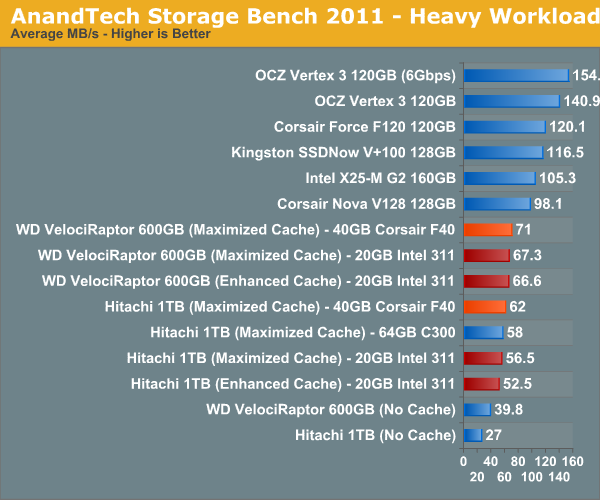
In our launch article we found that even Crucial's 64GB RealSSD C300 wasn't able to significantly outperform the 311, the situation isn't much different with the F40. The good news is that you do get twice the capacity and technically better performance, which could result in more of your data being in the cache at once.
The breakdown of reads vs. writes tells us more of what's going on:
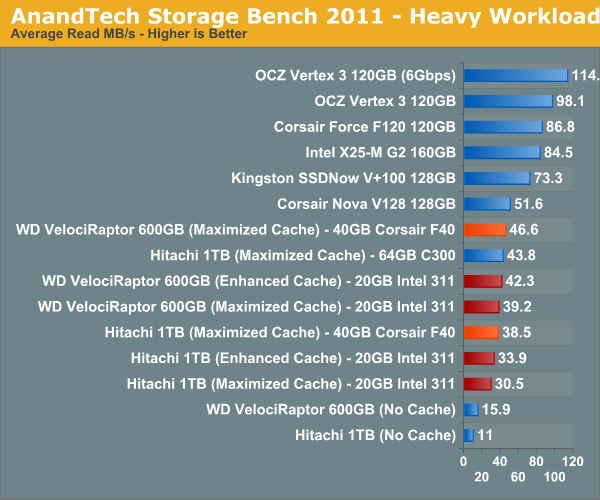
Read performance is actually where the F40 shines, surprisingly enough. This would imply that the majority of reads being cached are highly compressible in nature, playing to the F40's strengths. The write performance is a different story however:
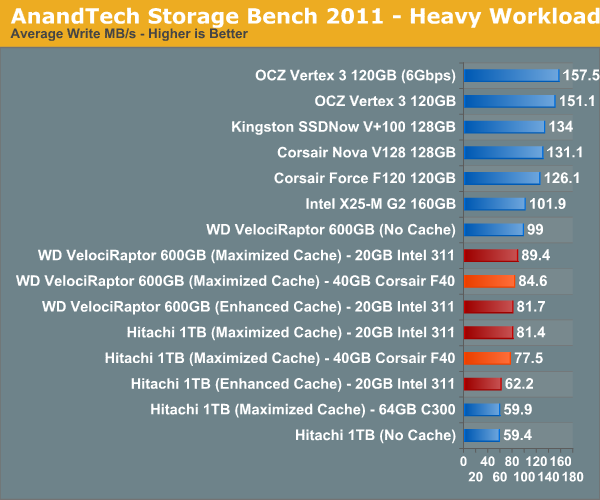
There isn't a huge difference here, but the 311 does pull ahead in the writes that occur during our test. Overall I'd say the F40 and 311 are pretty equal here, which is a good thing given the capacity advantage.
The next three charts just represent the same data, but in a different manner. Instead of looking at average data rate, we're looking at how long the disk was busy for during this entire test. Note that disk busy time excludes any and all idles, this is just how long the SSD was busy doing something:
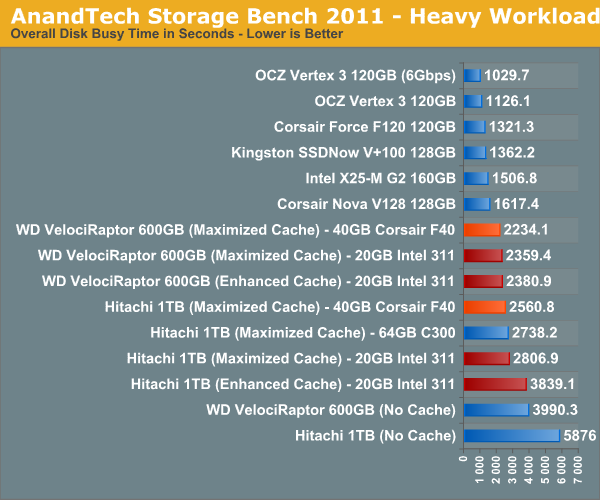
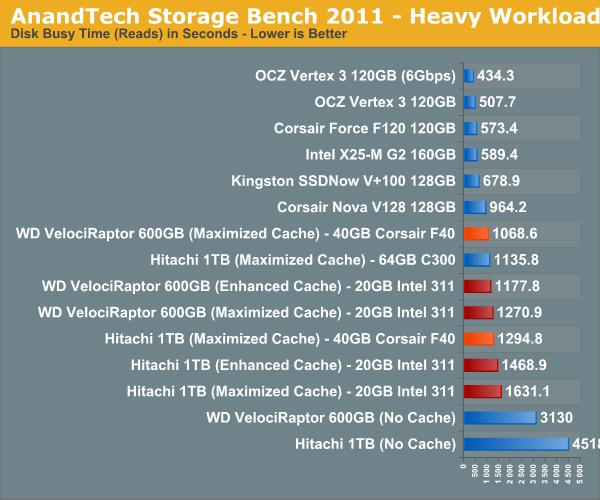
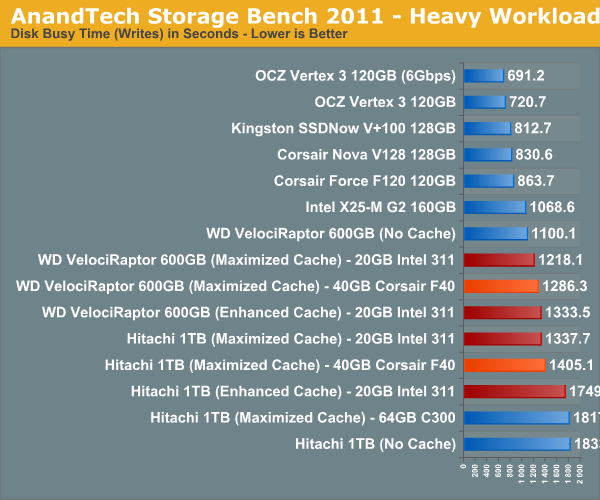










81 Comments
View All Comments
jordanclock - Friday, May 13, 2011 - link
I like the idea of this article and it starts providing some extra data that was asked for in the original review: What about other SSDs? Could we get some more SSDs tested with SRT? I'm not expecting Vertex 3s, but some "older" SSDs like the F40 that would likely be replaced soon.MrSpadge - Friday, May 13, 2011 - link
Currently Anand tested 3 mid- to high performance SSDs and I think this gives us a pretty good picture overall. However, if another one was tested I'd want the 64 GB Agility 3 and/or Solid 3. Well, a proper review of them would be very nice anyway ;)MrS
Cow86 - Friday, May 13, 2011 - link
Yea I was thinking the same thing...they supposedly perform a lot better, while still being reasonably affordable for the 60GB drives (~110 euro's here). Maybe they'd be the ultimate cache at a reasonable price point? Either way would love a review of those as well, vertex 3 is staying rather expensive :(jebo - Friday, May 13, 2011 - link
I agree that the Agility 3 and Solid 3 look very promising.therealnickdanger - Friday, May 13, 2011 - link
Plus, SRT works with drives up to 64GB, so it seems worth it to test a drive of that size. I imagine there are many users (such as myself) that have older Intel 80GB, Indilix 64GB, or SandForce SF1200/1500 64GB drives that will soon be replaced with faster 6Gbps drives.I would imagine that you could a drive of any size, especially the larger ~120GB SSDs that offer significant speed advantages over the 64GB models. SRT would limit the usable cache to 64GB, but it would still be interesting to see...
*wink**hint*
Boissez - Friday, May 13, 2011 - link
Yup - Here's another vote for that article. I have an 'old' 60GB agility 2 boot drive and a Z68 board on it's way. Question now is whether I keep it as boot drive or whether I take a performance hit and use it as cache. This article comes close to answering it yet Anandtech's own SSD workload benchmarks (which are the most interesting IMO) does not include the F40's numbers.GullLars - Tuesday, May 24, 2011 - link
If you can fit your OS and core apps/games on your agility 2, it's a no-brainer, keep it as you have. If you have a lot of apps and games you have had on HDDs and use often, you could concider trying it as cache.I have 3 computers with 32GB boot drives (1 laptop, HTPC, and a donated SSD to my fathers computer), and all of them get by fine with that with a little bit of management. You could concider using 30GB for caching and 30GB for OS + core apps, getting full SSD speed on the stuff you use the most, and have cache help out on game loads and more seldom used apps.
Mr Perfect - Friday, May 13, 2011 - link
That's what I'm thinking too. Get yourself the largest, fastest cache you can and see what happens. :) Currently that's looking like a 64GB Agility 3 or Solid 3.samsp99 - Friday, May 13, 2011 - link
I was just asking myself this very question...genji256 - Friday, May 13, 2011 - link
I'm confused. If the 311 performed better on the second run ("Intel 311 - Run 1" in your table), shouldn't that mean that the cache was large enough to store the data for all the applications (since they all ran during the first run)? If so, why would there suddenly be data evicted from the cache between the second and third run ("Intel 311 - Run 1" and "Intel 311 - Run 2" respectively)?